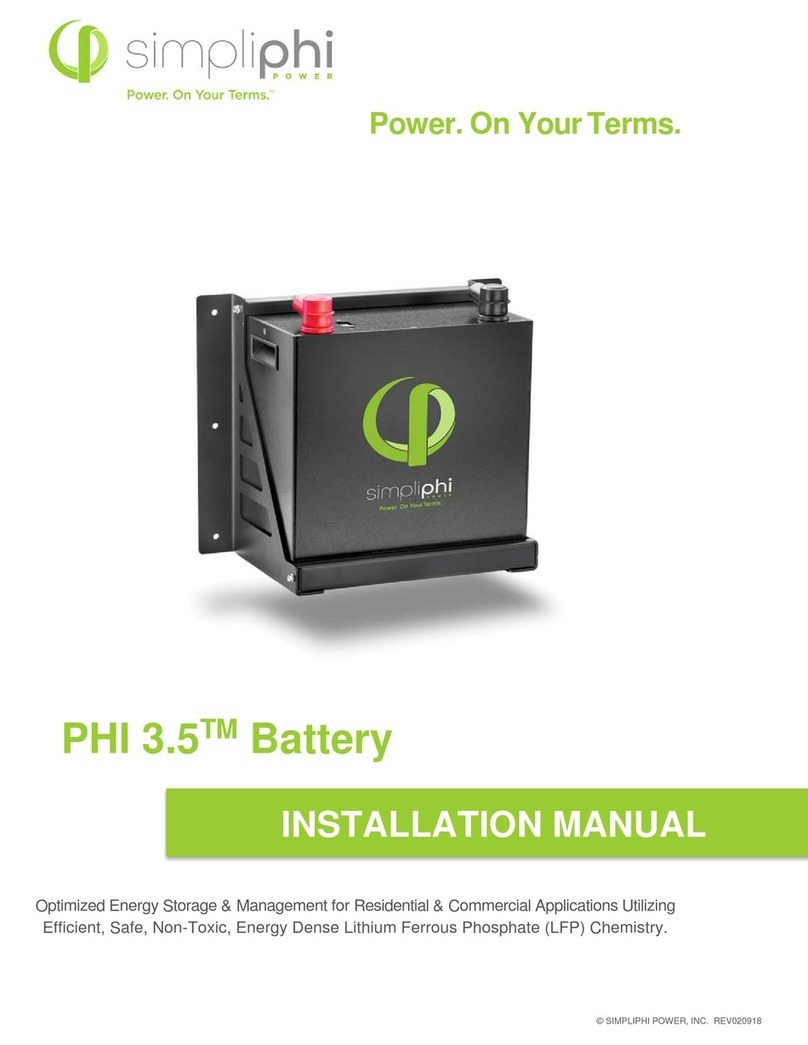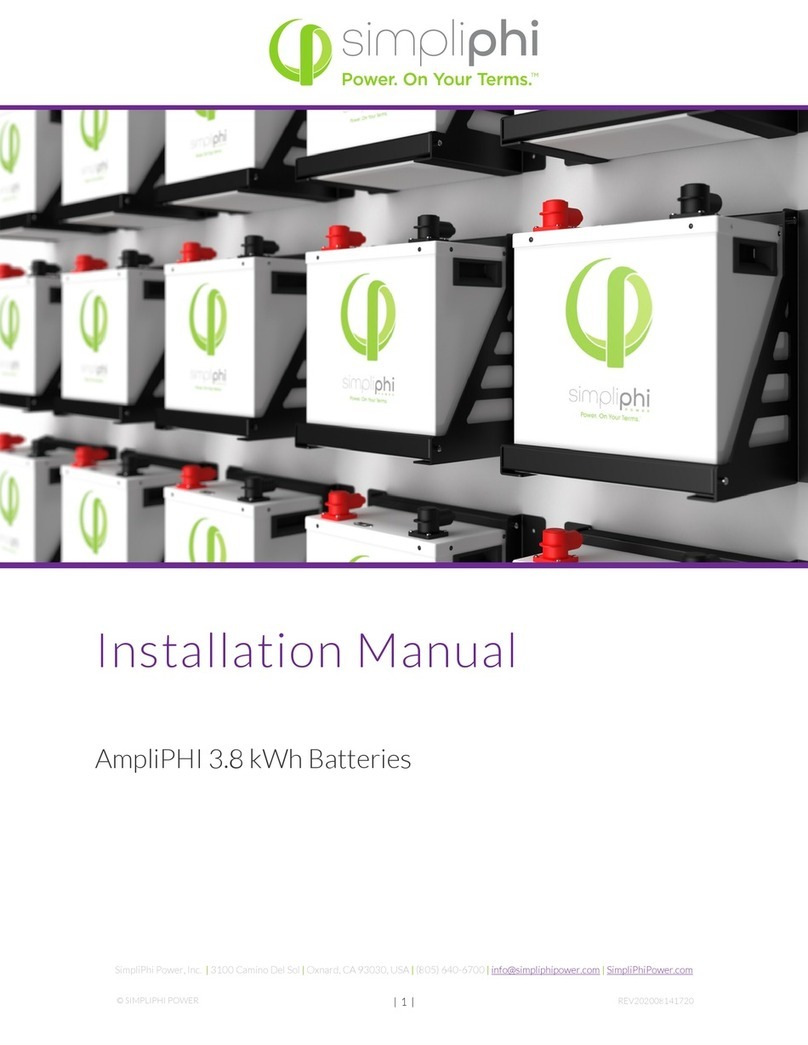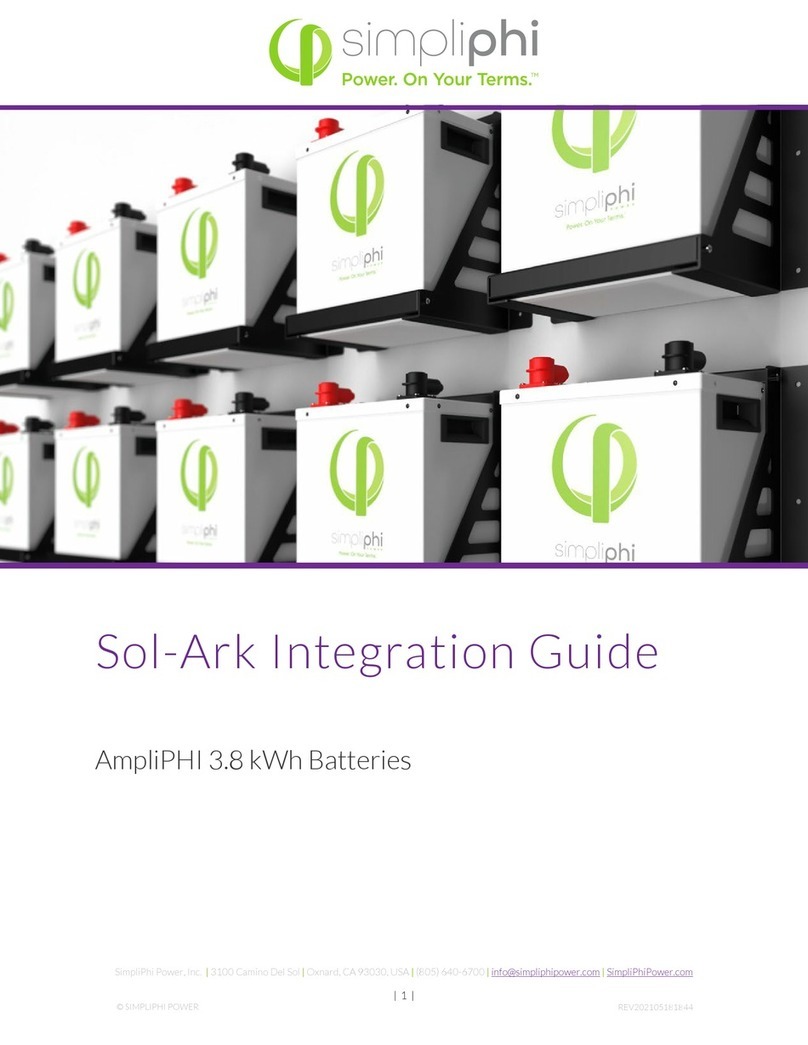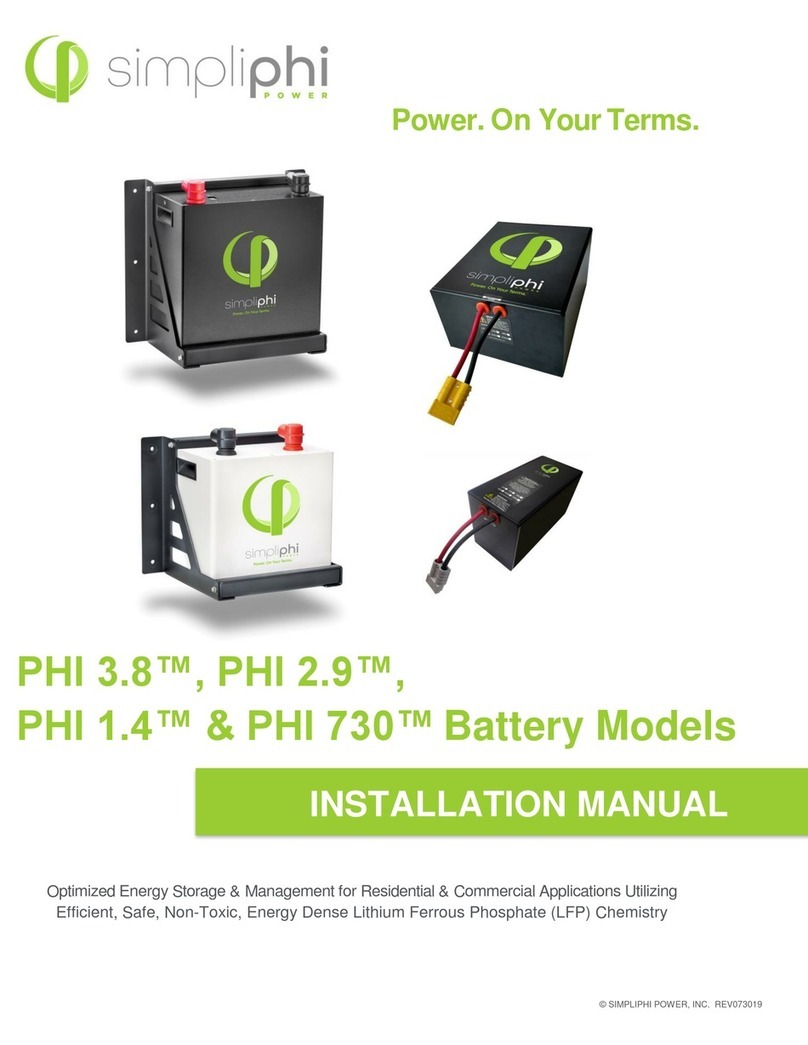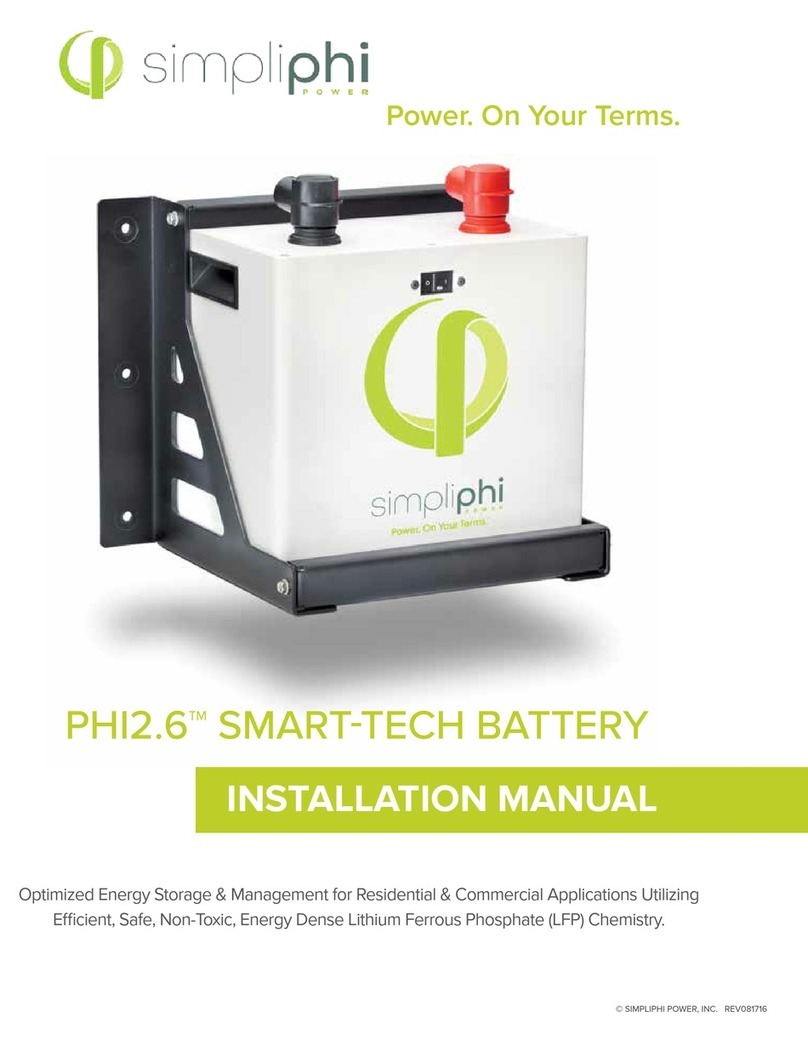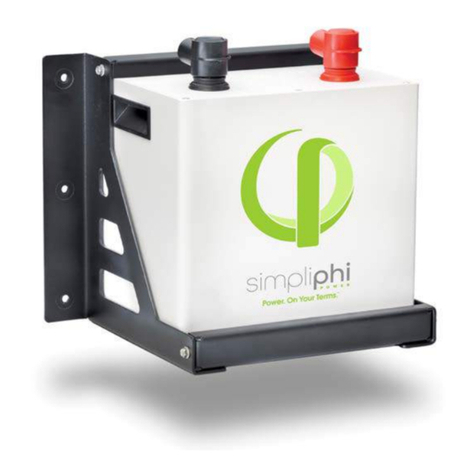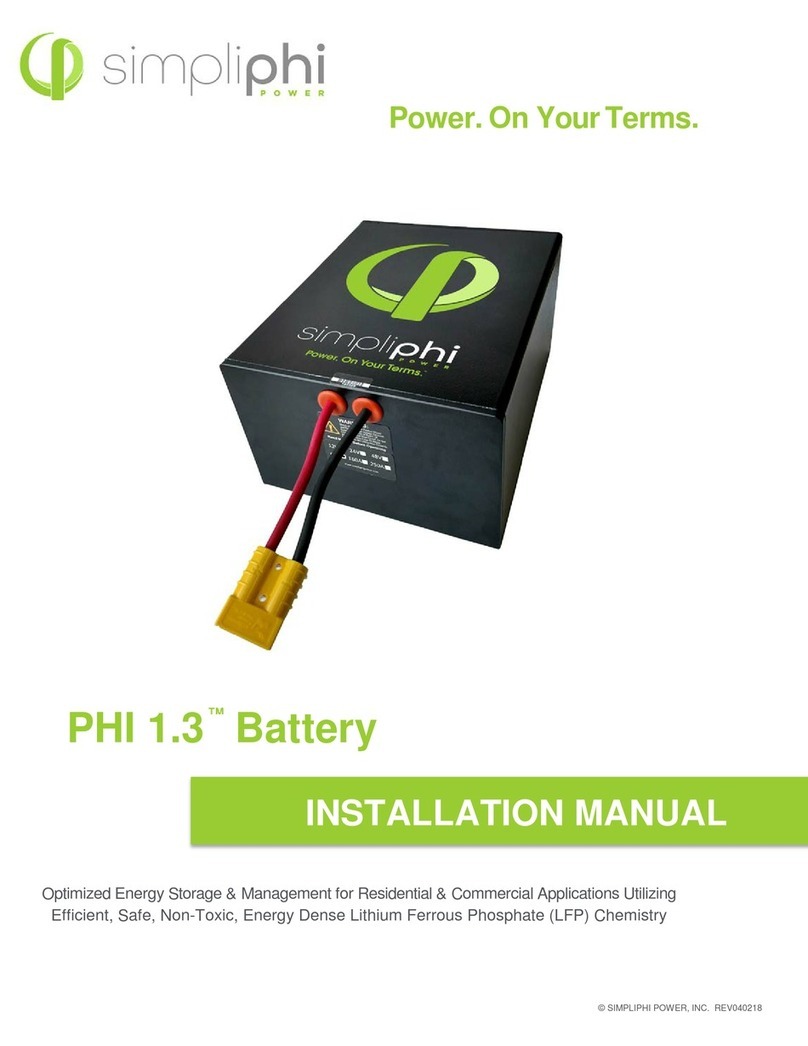SimpliPhi PHI 3.8 Series User manual

© SIMPLIPHI POWER, INC. REV020620

REV020620
SimpliPhi Power, Inc. | 3100 Camino Del Sol | Oxnard, CA 93030, USA | (805) 640-6700 | info@simpliphipower.com| SimpliPhiPower.com
| 2 |
SimpliPhi YourEnergy
Security and Independence
and gain control of your own power.
SimpliPhi Power helps you manage your power as a personal resource. Anytime.
Anywhere. SimpliPhi energy storage optimizes integration of any power
generation source –solar, wind, generator –on or off grid, and protects your
home and mission-critical business functions from power outages and
intermittency. SimpliPhi storage technology reduces operating temperature
constraints, toxic coolants and the risk of thermal runaway. Safe lithium ferrous
phosphate (LFP). No cobalt. No toxic hazards.
SimpliPhi’s battery technology utilizes the industry’s most environmentally
benign chemistry (LFP) combined with proprietary architecture and power
electronics (BMS) to create a portfolio of high performance, scalable and
enduring energy storage solutions that provide power security, resilience and
daily cycling for savings on your utility bill –all with a 98% efficiency rate.
SimpliPhi Power offers proprietary, commercially availableenergy storage and management
systems that are safe, non-toxic, reliable, durable, efficient, highly scalable, and economical over
the lifetime of the PHI Battery.

REV020620
SimpliPhi Power, Inc. | 3100 Camino Del Sol | Oxnard, CA 93030, USA | (805) 640-6700 | info@simpliphipower.com| SimpliPhiPower.com
| 3 |
Table of Contents
1.0 –Introduction ............................................................................................................................................................................................5
1.1 –Online Resources..................................................................................................................................................................................5
1.2 –Technical Support .........................................................................................................................................................................5
1.3 –Product Overview.........................................................................................................................................................................5
1.3.1 –Battery Management System (BMS)..........................................................................................................................5
1.3.2 –Built-In Breaker ...................................................................................................................................................................6
1.4 –Specifications ..................................................................................................................................................................................7
2.0 –Safety ..........................................................................................................................................................................................................8
2.1 –General Safety Instructions......................................................................................................................................................8
2.2 –Response to Emergency Situations.......................................................................................................................................8
3.0 –Pre-Installation ......................................................................................................................................................................................9
3.1 –PHI Battery Performance..........................................................................................................................................................9
3.2 –PHI Battery System Sizing.........................................................................................................................................................9
3.2.1 –Sizing for Maximum Instantaneous Discharge (Load Rate)..............................................................................9
3.2.2 –Sizing for Maximum Instantaneous Charge Rate (DC Coupled) .................................................................11
3.2.3 –Sizing for Maximum Instantaneous Charge Rate (AC Coupled)..................................................................12
3.2.4 –Overall Battery System Sizing ....................................................................................................................................13
4.0 –Installation ............................................................................................................................................................................................14
4.1 –Installation Options...................................................................................................................................................................14
4.2 –Environmental Considerations ............................................................................................................................................14
4.2.1 –Charging at Temperatures Below Freezing .........................................................................................................14
4.2.2 –Explosive Gas Precautions .................................................................................................................................................14
4.2.3 –Anti-Corrosion Protection...........................................................................................................................................14
4.3 –Mounting Hardware .................................................................................................................................................................14
4.4 –Dimensions and Weight ..........................................................................................................................................................15
4.5 –PHI Battery Connection Terminals....................................................................................................................................17
4.5.1 –Batteries with Threaded Studs ..................................................................................................................................17
4.5.2 –Torque Value for Batteries with Threaded Studs ..............................................................................................17
4.5.3 –Batteries with Anderson Connectors ......................................................................................................................17
4.6 –Wiring..............................................................................................................................................................................................18
4.6.1 –Increasing Storage Capacity via Parallel Wiring.................................................................................................18
4.6.2 –Parallel Wiring Batteries with Threaded Studs using Battery Cables ......................................................18
4.6.3 –Parallel Wiring Batteries with Threaded Studs using Interconnecting Busbars ..................................22
4.7 –Battery System Commissioning...........................................................................................................................................23
4.8 –Battery Bank Expansion ..........................................................................................................................................................25
5.0 –Programming.......................................................................................................................................................................................26
5.1 –Operating Parameters per Warranty................................................................................................................................26
6.0 –Troubleshooting.................................................................................................................................................................................28
Appendix A –PHI Battery Safety & Green Attributes, Certifications....................................................................................29
Appendix B –PHI Battery Bank Sizing Guide...................................................................................................................................32
Appendix C –PHI Approved External Chargers .............................................................................................................................36
Appendix D –PHI Legacy Battery Parameters ................................................................................................................................37

REV020620
SimpliPhi Power, Inc. | 3100 Camino Del Sol | Oxnard, CA 93030, USA | (805) 640-6700 | info@simpliphipower.com| SimpliPhiPower.com
| 4 |
CAUTION: THESE 5 THINGS WILL VOID THE PHI WARRANTY & DAMAGE THE
BATTERIES. READ IN FULL PRIOR TO BATTERY INSTALLATION
The following abbreviated guidelines do NOT encompass all PHI battery Warranty details. Failure to adhere
to the Warranty and Installation Manual requirements will Void the Warranty. Read the battery’s complete
Warranty prior to installation and register the battery according to the form found at the bottom of the same
web page address: https://simpliphipower.com/wp-content/uploads/documentation/phi-series/simpliphi-
power-phi-3-8-2-9-1-4-730-warranty.pdf.
CAUTION: The following will result in damage to your PHI batteries and will Void the Warranty:
1. Incorrect battery wiring and/or installation
a. Verify polarity at all connections with a standard voltmeter (1) before energizing the system and (2)
on batteries with threaded stud connections, before switching the built-in circuit breaker to the “ON”
position. Reverse polarity at the PHI Battery terminals will Void the Warranty and destroy the PHI
Batteries.
b. PHI Batteries must be fully charged before commissioning (i.e. before connecting loads). Failure to do
so will damage the PHI batteries and Void the Warranty.
c. Lugs, washers and lug nuts must be installed according to the Installation Manual. Failure to do so will
damage the PHI Batteries and Void the Warranty.
2. Charging the battery in sub-freezing temperatures.
3. Pairing the battery with incompatible equipment. Use of accessories not recommended or sold by the
manufacturer may result in a risk of fire, electric shock, or injury to persons and will Void the Warranty.
a. Contact SimpliPhi Technical Support at (805) 640-6700 x 1 regarding the compatibility of any
equipment not explicitly listed in the ‘Integration Guides’ section of the Product Documentation web
page (https://simpliphipower.com/product-documentation/).
b. Refer to the SimpliPhi-Approved Chargers list (Appendix C of this document) for all compatible
external / plug-in battery chargers. Use only a SimpliPhi-approved LFP battery charger if ancillary
charging is required before installation, testing or troubleshooting. Failure to use a SimpliPhi-
approved LFP battery charger will damage the PHI Battery and Void the Warranty.
4. Incorrect inverter and/or charge controller settings. Operating the PHI Battery in conjunction with
equipment not programmed to the PHI Battery’s settings will Void the Warranty.
a. Refer to the ‘Integration Guides’ section of the Product Documentation web page
(https://simpliphipower.com/product-documentation/) for all inverter and charge controller settings.
b. Although each PHI Battery contains an internal Battery Management System (BMS) with circuitry
that protects the PHI Battery cells from over-charge, over-discharge and extreme load amperage, the
PHI Battery must always be installed with appropriate inverter and/or charge controller settings and
power electronics to protect the PHI Battery from open solar photovoltaic (PV) voltage and other
high voltage charging sources.
c. Failure to protect the PHI batteries from voltages higher than the battery voltage rating (12, 24 &
48V) will destroy the PHI batteries, cause electrical fires and Void the Warranty.
5. Incorrect battery bank sizing.
a. Exceeding the PHI batteries’ maximum continuous discharge rate or charge rate destroys the PHI
batteries and will Void the Warranty.
b. Refer to Section 3.2 and Appendix B of this Manual for more information on how to accurately and
correctly calculate the PHI battery bank capacity. Failure to do so will destroy the PHI batteries and
Void the Warranty.

REV020620
SimpliPhi Power, Inc. | 3100 Camino Del Sol | Oxnard, CA 93030, USA | (805) 640-6700 | info@simpliphipower.com| SimpliPhiPower.com
| 5 |
The PHI Battery Warranty does NOT cover product damage caused by mishandling or improper use per the
Installation Manual, Integration Guides and Warranty, exposure to liquids, impacts from falling objects or
being dropped, or attempts to repair the battery by any party other than SimpliPhi. The complete list of
Warranty Exclusions is included in the PHI Battery Warranty document: https://simpliphipower.com/wp-
content/uploads/documentation/phi-series/simpliphi-power-phi-3-8-2-9-1-4-730-warranty.pdf.
1.0 –Introduction
1.1 –Online Resources
The Product Documentation section of SimpliPhi’s web site (https://simpliphipower.com/product-
documentation/) includes Specification Sheets, Warranties, Installation & Operator’s Manuals, and
Integration Guides for all SimpliPhi’s current and legacy products.
SimpliPhi’s YouTube channel (https://www.youtube.com/channel/UCcuCaLT_G3Hhumteh-pI5yg/videos) has
instructional videos showing various steps of the battery installation process in detail.
1.2 –Technical Support
SimpliPhi Technical Support (805-640-6700 x 1, techsupport@simpliphipower.com) is available to take any
questions regarding this manual or general installation questions. For assistance with battery system
commissioning, SimpliPhi asks that a commissioning call be scheduled ahead of time with Technical Support.
We encourage you or your installer to contact SimpliPhi with any questions. We are committed to working with
you and your installation team to achieve a safe, reliable storage system that will provide years of maintenance-
free service that is covered by our Warranty terms & conditions.
1.3 –Product Overview
The PHI deep-cycle Lithium Ferro Phosphate (LFP) Battery is optimized with proprietary cell architecture,
power electronics, Battery Management System (BMS), manufacturing materials and processes. This assures
the highest grade and quality, longest cycle-life, greatest efficiency and freedom from material impurities,
toxicity and hazardous risk. The PHI Battery is modular, lightweight and scalable. It provides power security
and seamless integration of renewable and traditional sources of energy in conjunction with or independent of
the grid.
1.3.1 –Battery Management System (BMS)
Each PHI Battery contains circuitry that protects the LFP cells from overcharge, over-discharge and
extreme load amperage. If pre-programmed BMS values are exceeded, the protective circuitry will
shut down the flow of electricity to/from the PHI Batteries. In some cases, this will result in the need
to re-set the BMS (see Section 6.0 - Troubleshooting of this Manual) and re-initialize an
inverter/charger. Often, inverter system settings will be saved within the inverter memory storage
and will not need to be reset. However, this is not an absolute standard but is common in most
inverter/chargers and should be anticipated if the PHI Batteries go into a state of self-protection and
shut down the flow of electricity. Refer to SimpliPhi’s Integration Guides for inverter and/or charge
controller settings (https://simpliphipower.com/product-documentation/).
Other manuals for PHI 3.8 Series
1
This manual suits for next models
3
Table of contents
Other SimpliPhi Camera Accessories manuals
Popular Camera Accessories manuals by other brands

Trojan
Trojan GC2 48V quick start guide

Calumet
Calumet 7100 Series CK7114 operating instructions

Ropox
Ropox 4Single Series User manual and installation instructions

Cambo
Cambo Wide DS Digital Series Main operating instructions

Samsung
Samsung SHG-120 Specification sheet

Ryobi
Ryobi BPL-1820 Owner's operating manual
